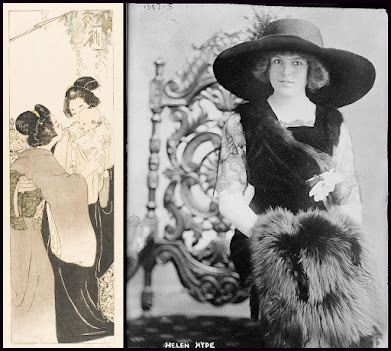Plot 16, Lot 7
Helen Hyde and Grave Marker
Helen Hyde was an American artist whose pioneering work in printmaking and Japonist aesthetics earned her international acclaim in the early 20th century. Best known today for her delicate color woodblock prints, Hyde’s artistic vision bridged the cultural worlds of East and West at a time when such synthesis was rare, particularly for Western women artists.
Born in Lima, New York, and raised in San Francisco, Helen Hyde pursued rigorous artistic training across the United States and Europe. She studied painting, sketching, and printmaking in institutions and under private tutelage in New York, Berlin, and Paris. A major influence during her European education was the French artist Félix Régamey, a prominent Japonist whose own work and collection introduced Hyde to the aesthetics and philosophy of Japanese art. She was also inspired by Mary Cassatt, the American Impressionist who used Japanese composition and color in her own work.
 |
| Full page feature in San Francisco Call, Oct 23, 1910 |
The 1904 San Francisco Call praised her as a “fair compatriot” whose prints stood beside Rembrandt’s etchings in terms of emotional resonance and visual delicacy. Her exhibition of forty-two watercolors and woodblock prints in San Francisco drew critical acclaim for capturing “the delicacy of watercolors and the depth and richness of oil, but not neither.” Among her most noted pieces were The Lantern Lighter, Yellow Umbrellas, Rainy Day Tokyo, and Cherry Blossom Time. She was awarded first prize and a gold medal at a major Tokyo exhibition, a rare honor for a foreign woman artist.
 |
| Helen Hyde and Japanese inspired woodblock |
Hyde’s travels were not limited to Japan. She ventured to China, India, and later Mexico, always with sketchbook in hand, seeking to capture everyday life with quiet dignity. Despite being a globe-trotter, her work remained deeply personal, often portraying mothers and children in tender moments, rendered with refined lines and subtle coloring.
 |
| Article with artwork from San Francisco Sunday Call, Nov 10, 1901 |
Helen Hyde remains a singular figure in American art history—an artist who transcended geographic and cultural boundaries, crafting a visual language rooted in reverence, observation, and shared humanity.
Sources: San Francisco Call, Wikipedia, Find a Grave,
No comments:
Post a Comment